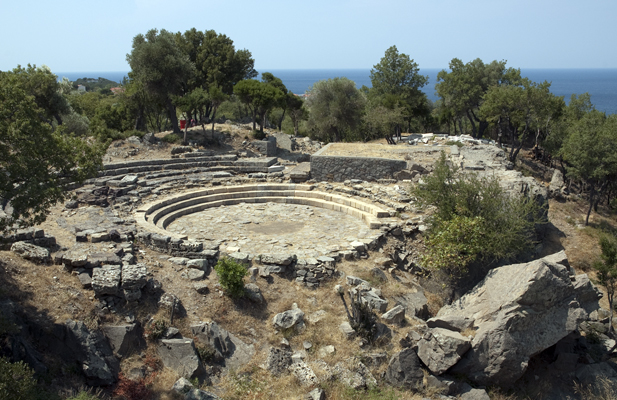(25) Theatral Circle
End of 5th century or early 4th century B.C.
Limestone, andesite fieldstone, sandstone
Eastern Hill
Paved floor: ca. 9.07 to 9.21 m in diameter
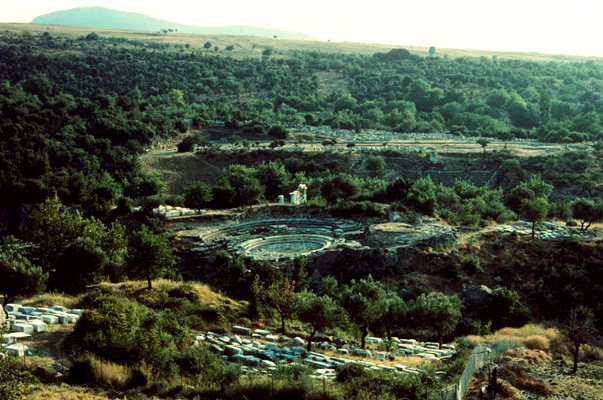
Originally constructed at the end of the fifth or beginning of the fourth century B.C., the Theatral Circle is the earliest preserved permanent ritual gathering space for pilgrims to the Sanctuary of the Great Gods. Although the region was increasingly embellished with additional buildings and dedications, the Theatral Circle remained the center of ritual activity on the Eastern Hill for over five hundred years.
After passing over the eastern torrent, officials of the cult and prospective initiates would descend into this sunken open-air theatron framed by bedrock outcroppings, located at the edge of a ravine that bounded the Sanctuary to the northeast. This circular court has an orchestral shape and is paved with flagstones of andesite. Although only three rows of steps survive today, five tiers of concentric limestone steps originally framed the Theatral Circle. They are too narrow for seats, but appropriate for a standing audience.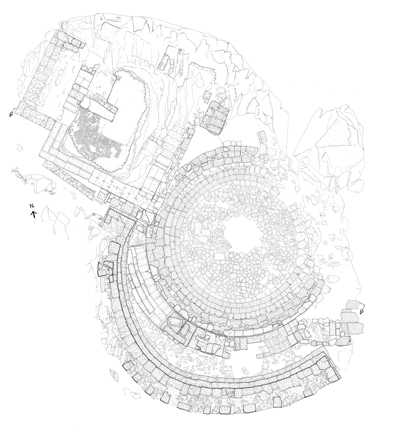 The design of the Theatral Circle has two distinct phases. In its original configuration, the orchestral space, ca. 9.07 to 9.21 m in diameter, was surrounded by at least four tiers of concentric limestone steps, supported by a packing of andesite fieldstone. The steps were interrupted by a passageway approximately 2 m wide that cut through the northwestern side, roughly opposite the place where the visitor would have entered the complex. A major renovation carried out in the first half of the fourth century B.C. closed this passageway with a continuous circle of steps, giving the structure its present form. The remodel also added new fourth and fifth rows of steps, this time on top of sandstone packing. Although parts of the structure and hillside along the northeastern edge have since fallen into the ravine, in antiquity the circle was continuous. In each of its iterations, the Theatral Circle defined a station along the Sacred Way and a distinct staging ground for the ritual experience against the natural backdrop of a deep ravine to the northeast, the Ayios Giorgios ridge to the southeast, and a panoramic view of the Aegean Sea to the north.
The design of the Theatral Circle has two distinct phases. In its original configuration, the orchestral space, ca. 9.07 to 9.21 m in diameter, was surrounded by at least four tiers of concentric limestone steps, supported by a packing of andesite fieldstone. The steps were interrupted by a passageway approximately 2 m wide that cut through the northwestern side, roughly opposite the place where the visitor would have entered the complex. A major renovation carried out in the first half of the fourth century B.C. closed this passageway with a continuous circle of steps, giving the structure its present form. The remodel also added new fourth and fifth rows of steps, this time on top of sandstone packing. Although parts of the structure and hillside along the northeastern edge have since fallen into the ravine, in antiquity the circle was continuous. In each of its iterations, the Theatral Circle defined a station along the Sacred Way and a distinct staging ground for the ritual experience against the natural backdrop of a deep ravine to the northeast, the Ayios Giorgios ridge to the southeast, and a panoramic view of the Aegean Sea to the north.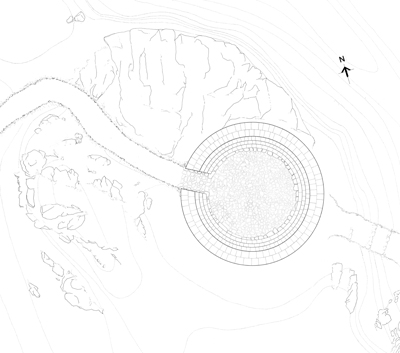 The Theatral Circle was a place of both performance and witness. The enclosed round space carries a semantic significance that suggests that the rites performed inside may have included song, dance, ritual theater, judgment, and/or sacrifice. No written source describes what actions were performed here, but the form of the circle with surrounding tiers of steps relates orchestra of the Greek theatron, a site in which to watch performed actions, the Greek khoros where dancing would occur, as well the Greek halos, or threshing floor, where the celebration of the harvest would take place.
The Theatral Circle was a place of both performance and witness. The enclosed round space carries a semantic significance that suggests that the rites performed inside may have included song, dance, ritual theater, judgment, and/or sacrifice. No written source describes what actions were performed here, but the form of the circle with surrounding tiers of steps relates orchestra of the Greek theatron, a site in which to watch performed actions, the Greek khoros where dancing would occur, as well the Greek halos, or threshing floor, where the celebration of the harvest would take place.
Although less common, some altar complexes in ancient Greece also can be found in a similar circular form. James McCredie, the excavator, proposes that a cylindrical, molded block found on the Eastern Hill was the sacrificial altar that would have originally been placed at the center of the Theatral Circle. Given the Theatral Circle’s location, Susan Cole proposes that here prospective initiates received the praefatio sacrorum to exclude the unfit, as well as sacred instructions for what was to follow deeper in the Sanctuary. Kevin Clinton suggests that the purificatory rite of thronosis may have been performed in this space and constituted preliminary initiation, or myesis. These actions are not mutually exclusive. The preliminary position of the Theatral Circle along the path of the Sacred Way indicates that the rites performed here must have prepared visitors for what was to come during initiation.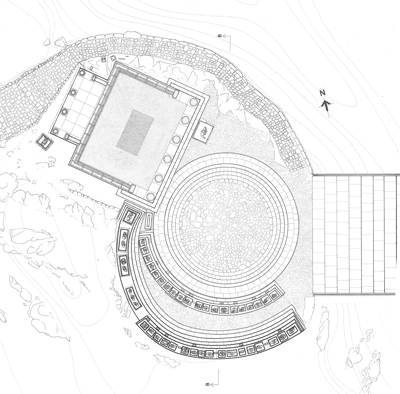 Whatever actions took place inside the circle, it is clear that the surrounding steps were meant to accommodate an audience. Approximately 240 people could stand together to witness and take part in rites performed in the Theatral Circle. The relatively small scale of the circle, just over nine meters in diameter, combined with the fact that audience members would stand, rather than sit, indicate that audience participation was integral to the experience within the Theatral Circle. In such an intimate space, pilgrims watched the actions performed against the backdrop of their fellow initiands, forming a communal bond before proceeding to the main rites below in the heart of the Sanctuary.
Whatever actions took place inside the circle, it is clear that the surrounding steps were meant to accommodate an audience. Approximately 240 people could stand together to witness and take part in rites performed in the Theatral Circle. The relatively small scale of the circle, just over nine meters in diameter, combined with the fact that audience members would stand, rather than sit, indicate that audience participation was integral to the experience within the Theatral Circle. In such an intimate space, pilgrims watched the actions performed against the backdrop of their fellow initiands, forming a communal bond before proceeding to the main rites below in the heart of the Sanctuary.
Selected Bibliography:
McCredie, J.R. 1968. “Samothrace: Preliminary Report on the Campaigns of 1965-1967,” Hesperia 37, pp. 216-233.
Wescoat, B.D. 2006. “Recent Work on the Eastern Hill of the Sanctuary of the Great Gods, Samothrace,” in Mattusch, C., A. Donahue, and A. Brauer, eds. Proceedings of the XVI International Congress of Classical Archaeology, Boston, August 23-26, 2003. Common Ground: Archaeology, Art, Science, and Humanities. Oxford, pp. 79-83.
Wescoat, B. D. et. al. forthcoming. Samothrace. Excavations Conducted by the Institute of Fine Arts of New York University, Vol. 9, The Monuments of the Eastern Hill.

